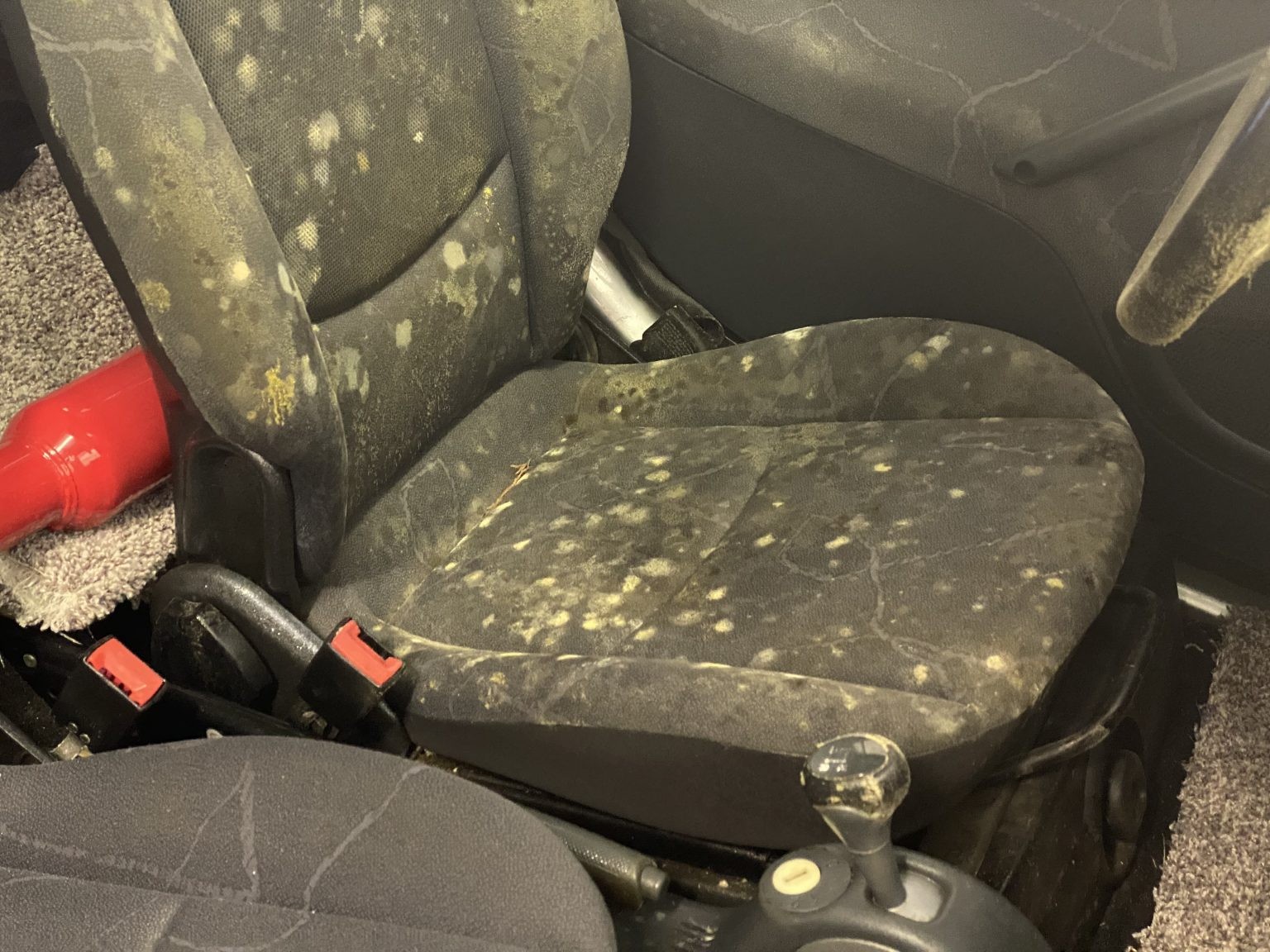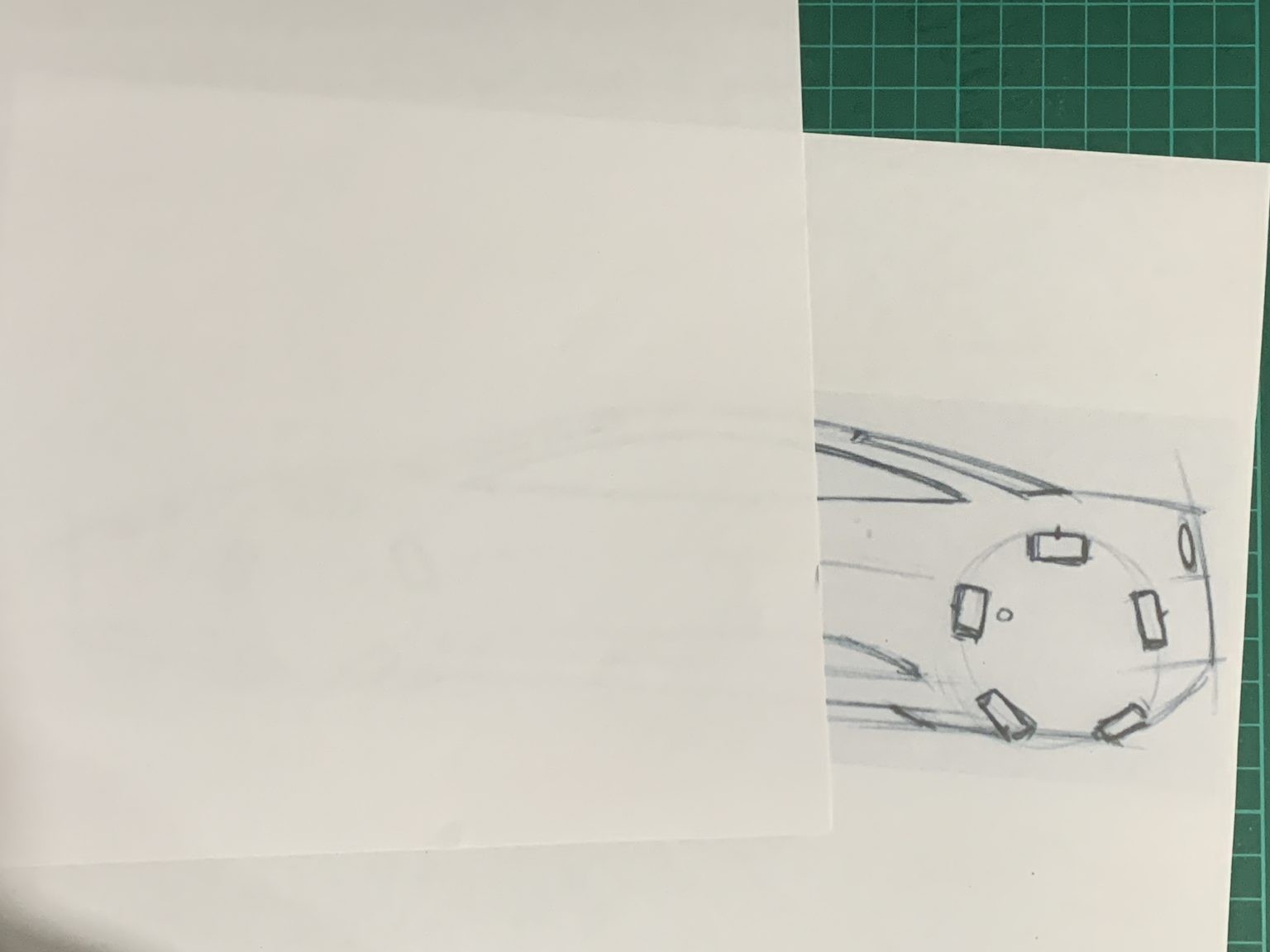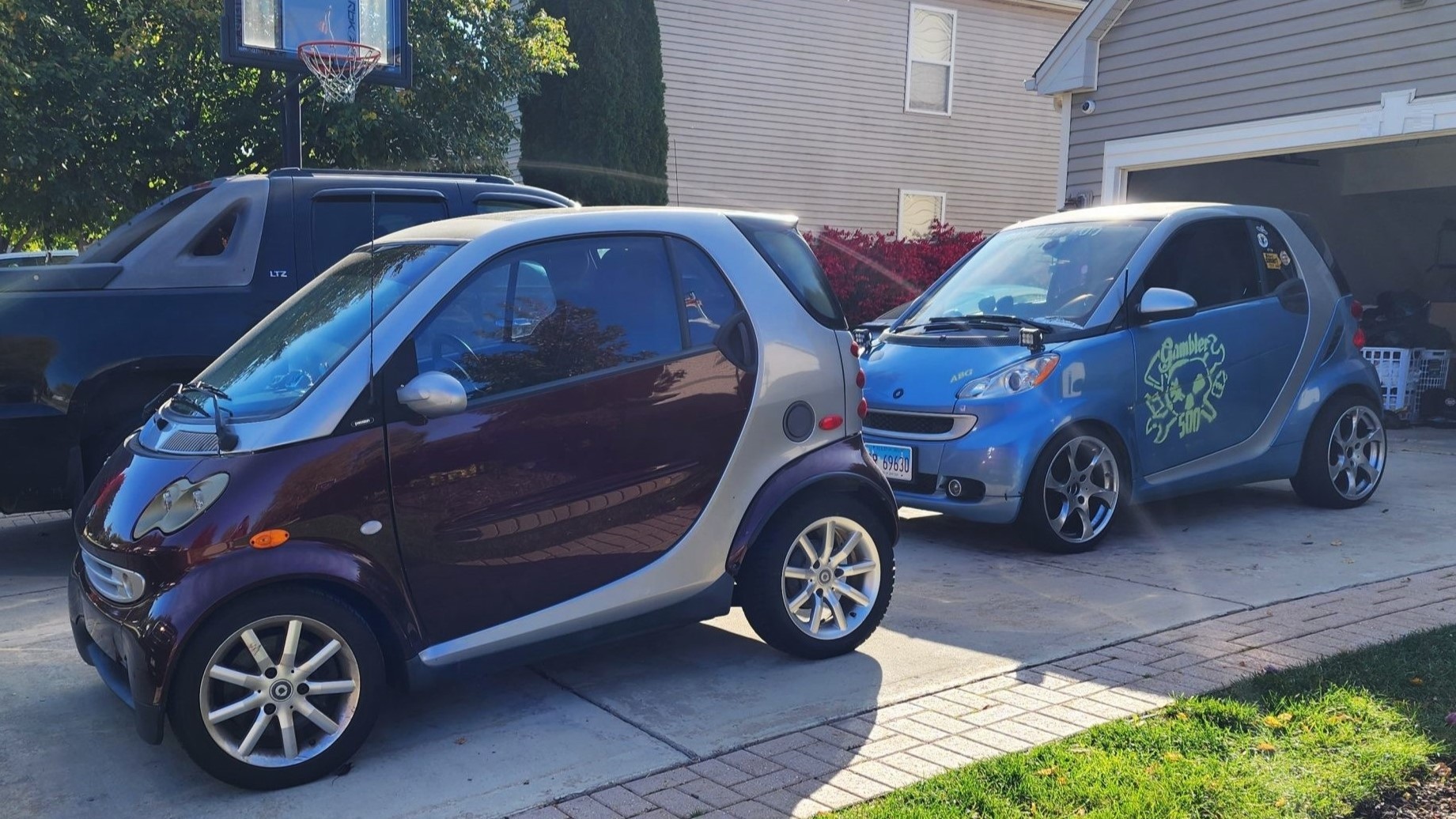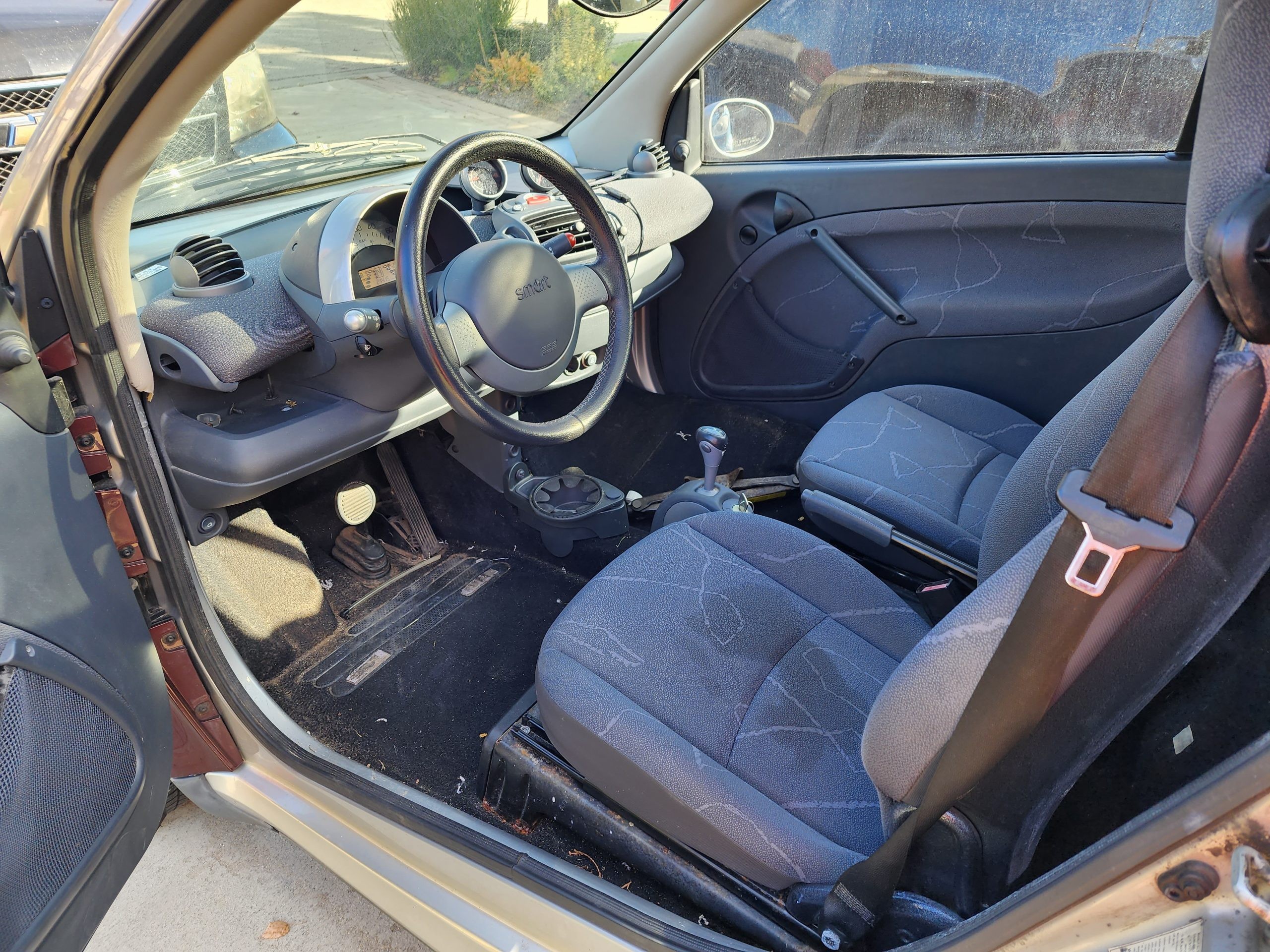How Do You Remove Mold From Car Interior? At CARS.EDU.VN, we understand the frustration and health concerns associated with mold contamination in your vehicle and offer effective solutions. This article guides you through expert-backed methods to eliminate mold and prevent its return, ensuring a clean and healthy driving environment with mold removal, car detailing, and interior cleaning.
1. Identifying Mold and Its Causes in Your Car
Mold in your car is more than just an eyesore; it’s a potential health hazard and can damage your vehicle’s interior. Recognizing the signs of mold and understanding its causes are the first steps in effectively dealing with this issue.
1.1. Recognizing the Signs of Mold
Mold can manifest in various ways, often subtly at first. Here are some common indicators:
- Musty Odor: A persistent, unpleasant smell is often the first sign of mold.
- Visible Spots: Look for discoloration or spots on seats, carpets, or the headliner. Mold can appear in various colors, including white, green, black, or brown.
- Allergic Reactions: Unexplained allergy symptoms like sneezing, coughing, or skin irritation while in the car could indicate mold presence.
1.2. Common Causes of Mold Growth in Cars
Mold thrives in moist environments. Understanding the common causes can help prevent future outbreaks:
- Water Leaks: Leaks from windows, sunroofs, or seals can introduce moisture.
- Spills: Food and drink spills, if not cleaned thoroughly, can create a breeding ground for mold.
- Humidity: High humidity levels, especially in poorly ventilated cars, can encourage mold growth.
- Wet Items: Leaving wet clothes, umbrellas, or other items in the car can introduce moisture.
1.3. Health Risks Associated with Mold Exposure
Exposure to mold can cause various health problems, especially for those with allergies or respiratory issues. According to the Environmental Protection Agency (EPA), mold exposure can lead to:
- Allergic Reactions: Sneezing, runny nose, red eyes, and skin rash.
- Asthma Attacks: Mold can trigger asthma symptoms in sensitive individuals.
- Respiratory Infections: Prolonged exposure can lead to more severe respiratory issues.
2. Preparing to Remove Mold From Your Car
Before diving into the cleaning process, proper preparation is crucial to ensure your safety and the effectiveness of the mold removal.
2.1. Gathering Essential Cleaning Supplies
Having the right supplies on hand will make the mold removal process smoother and more effective. Here’s a list of essential items:
- Personal Protective Equipment (PPE):
- Respirator or Mask: To avoid inhaling mold spores.
- Gloves: To protect your skin from mold and cleaning solutions.
- Eye Protection: Goggles or safety glasses to prevent irritation.
- Cleaning Solutions:
- Mold-Specific Cleaner: Choose a cleaner specifically designed for mold removal.
- Mild Detergent: For general cleaning and stain removal.
- White Vinegar: A natural and effective mold killer.
- Rubbing Alcohol: Useful for disinfecting surfaces.
- Cleaning Tools:
- Vacuum Cleaner: Preferably with a HEPA filter to trap mold spores.
- Stiff Brush: For scrubbing moldy areas.
- Microfiber Cloths: For wiping surfaces clean.
- Spray Bottles: For applying cleaning solutions.
- Detailing Brushes: For reaching tight spots and crevices.
- Optional Equipment:
- Steam Cleaner: For deep cleaning and sanitizing surfaces.
- Ozone Generator: To eliminate odors and kill remaining mold spores (use with caution and follow safety guidelines).
2.2. Safety Precautions to Take
Mold removal can be hazardous, so it’s important to take necessary safety precautions:
- Ventilation: Work in a well-ventilated area. Open all car doors and windows.
- Avoid Direct Contact: Always wear gloves, a mask, and eye protection.
- Protect Yourself: If you have a history of respiratory issues or mold allergies, consider hiring a professional for mold removal.
- Read Product Labels: Follow the manufacturer’s instructions for all cleaning products.
- Dispose of Contaminated Materials Properly: Seal contaminated items in plastic bags before disposal to prevent spreading mold spores.
2.3. Testing a Small Area First
Before applying any cleaning solution to a large area, test it on a small, inconspicuous spot to ensure it doesn’t damage or discolor the material. This is especially important for fabric and upholstery.
3. Step-by-Step Guide to Removing Mold From Your Car Interior
With your supplies gathered and safety measures in place, follow these steps to effectively remove mold from your car’s interior.
3.1. Initial Cleaning and Vacuuming
Start by removing any loose items from your car and giving the interior a thorough vacuuming.
- Remove Debris: Take out any trash, personal items, and removable car mats.
- Vacuum Thoroughly: Use a vacuum cleaner with a hose attachment to reach all areas, including seats, carpets, headliner, and vents.
- Focus on Moldy Areas: Pay special attention to areas where mold is visible, but be careful not to spread the spores.
3.2. Cleaning Moldy Surfaces
Once you’ve vacuumed, proceed with cleaning the moldy surfaces using your chosen cleaning solution.
- Prepare Cleaning Solution: Depending on your preference, use a mold-specific cleaner, white vinegar, or a mixture of mild detergent and water.
- Apply Solution: Spray the cleaning solution onto a microfiber cloth (do not saturate the surface directly).
- Scrub Gently: Gently scrub the moldy areas with the damp cloth. For stubborn mold, use a soft-bristled brush.
- Wipe Clean: Use a clean, damp microfiber cloth to wipe away the cleaning solution and any remaining mold residue.
- Dry Thoroughly: Use a dry microfiber cloth to absorb as much moisture as possible.
3.3. Deodorizing and Disinfecting
After cleaning, deodorizing and disinfecting are crucial to eliminate odors and kill any remaining mold spores.
- Apply Disinfectant: Spray a disinfectant solution (such as rubbing alcohol) lightly on the cleaned surfaces.
- Air Out the Car: Open all doors and windows to allow fresh air to circulate.
- Use an Ozone Generator (Optional): If you choose to use an ozone generator, follow the manufacturer’s instructions carefully. Ensure the car is unoccupied and well-ventilated after treatment.
3.4. Drying the Car Interior
Thorough drying is essential to prevent mold from returning.
- Open Doors and Windows: Allow the car to air dry in the sun, if possible.
- Use a Dehumidifier: Place a dehumidifier inside the car to remove excess moisture.
- Apply Baking Soda: Sprinkle baking soda on carpets and upholstery to absorb moisture and odors. Let it sit for several hours, then vacuum it up.
4. Specific Cleaning Solutions and Their Applications
Choosing the right cleaning solution is critical for effective mold removal without damaging your car’s interior.
4.1. White Vinegar
- How to Use: Mix equal parts white vinegar and water in a spray bottle. Apply to moldy surfaces, let it sit for 15-20 minutes, then wipe clean and dry thoroughly.
- Pros: Natural, non-toxic, and effective at killing mold.
- Cons: Can leave a strong odor that may take time to dissipate.
4.2. Baking Soda
- How to Use: Make a paste of baking soda and water, apply to moldy areas, let it dry, then vacuum.
- Pros: Absorbs moisture and odors, gentle on surfaces.
- Cons: May not be effective for heavy mold infestations.
4.3. Commercial Mold Removers
- How to Use: Follow the manufacturer’s instructions. Typically involves spraying the solution on the moldy area, letting it sit for a specified time, and then wiping clean.
- Pros: Formulated for effective mold removal, often contains disinfectants and deodorizers.
- Cons: Can be harsh and may contain chemicals that require careful handling.
4.4. Bleach Solution
- How to Use: Mix one part bleach with ten parts water. Apply to non-porous surfaces only, let it sit for a few minutes, then wipe clean and dry thoroughly.
- Pros: Effective at killing mold and disinfecting surfaces.
- Cons: Can discolor fabrics and damage certain materials, releases harmful fumes, and should only be used in well-ventilated areas.
Important Note: Never mix bleach with ammonia or other cleaning products, as it can create toxic fumes.
5. Dealing with Mold in Specific Areas of Your Car
Mold can appear in different areas of your car, each requiring specific cleaning approaches.
5.1. Mold on Car Seats
- Vacuum: Start by vacuuming the seats thoroughly to remove loose mold spores.
- Spot Clean: Use a mold-specific cleaner or a mixture of white vinegar and water to spot clean the affected areas.
- Steam Clean: If the seats are heavily infested, consider using a steam cleaner to deep clean and sanitize the fabric.
- Dry Thoroughly: Ensure the seats are completely dry to prevent mold from returning.
5.2. Mold on Carpets and Floor Mats
- Remove Mats: Take out any removable floor mats and clean them separately.
- Vacuum: Vacuum the carpets thoroughly.
- Apply Cleaning Solution: Spray the affected areas with a mold remover or a mixture of white vinegar and water.
- Scrub: Use a stiff brush to scrub the carpets.
- Dry: Use a wet/dry vacuum to remove excess moisture, then allow the carpets to air dry completely.
5.3. Mold on the Headliner
Cleaning the headliner requires extra care to avoid damaging the fabric.
- Vacuum: Gently vacuum the headliner with a soft brush attachment.
- Spot Clean: Use a microfiber cloth dampened with a mild cleaning solution to gently blot the moldy areas.
- Dry: Use a clean, dry microfiber cloth to absorb any excess moisture.
- Ventilate: Open the car doors and windows to allow the headliner to air dry.
5.4. Mold in the Air Conditioning System
Mold in the AC system can cause unpleasant odors and spread spores throughout the car.
- Replace Cabin Air Filter: Replace the cabin air filter to remove trapped mold spores.
- Use AC Cleaner: Use an AC cleaner specifically designed to kill mold and bacteria in the system.
- Run AC on High: Run the AC on high with the windows open to circulate the cleaner and remove odors.
6. Preventing Mold From Returning
Once you’ve successfully removed the mold, take these steps to prevent it from coming back:
6.1. Control Moisture Levels
- Fix Leaks: Address any water leaks promptly.
- Avoid Leaving Wet Items: Don’t leave wet clothes, umbrellas, or towels in the car.
- Use Dehumidifiers: In humid climates, use a car dehumidifier to absorb excess moisture.
6.2. Regular Cleaning and Maintenance
- Vacuum Regularly: Vacuum the interior of your car regularly to remove dirt and debris that can trap moisture.
- Clean Spills Immediately: Clean up any spills as soon as they happen.
- Air Out the Car: Occasionally air out the car by opening the doors and windows, especially after rain or humid weather.
6.3. Using Moisture Absorbers
- Silica Gel Packets: Place silica gel packets in the car to absorb moisture.
- Charcoal Bags: Charcoal bags can also help absorb moisture and odors.
6.4. Professional Detailing Services
Consider professional detailing services for a thorough cleaning and mold prevention treatment. Professional detailers have the expertise and equipment to effectively remove mold and protect your car’s interior.
7. When to Call a Professional
In some cases, mold infestations may be too severe to handle on your own. Here are situations where you should consider calling a professional:
- Extensive Mold Growth: If mold covers a large area of your car’s interior.
- Persistent Odors: If musty odors persist despite your cleaning efforts.
- Health Concerns: If you experience health issues related to mold exposure.
- Lack of Time or Expertise: If you don’t have the time or expertise to tackle the problem yourself.
7.1. Finding a Reputable Mold Remediation Service
When choosing a professional mold remediation service, consider the following:
- Experience and Certifications: Look for a company with experience in mold removal and relevant certifications.
- Customer Reviews: Check online reviews and testimonials to gauge the company’s reputation.
- Detailed Assessment: Ensure the company provides a thorough assessment of the mold problem.
- Safe Removal Methods: Ask about the methods and products they use for mold removal to ensure they are safe and effective.
- Warranty: Check if the company offers a warranty on their services.
8. The Role of CARS.EDU.VN in Automotive Care
At CARS.EDU.VN, we are committed to providing you with the knowledge and resources you need to maintain your vehicle in top condition. Whether you’re dealing with mold issues or seeking general car care advice, we’re here to help.
8.1. Comprehensive Car Care Resources
CARS.EDU.VN offers a wide range of articles, guides, and tutorials on various aspects of car care, including:
- Cleaning and Detailing: Tips on keeping your car’s interior and exterior clean.
- Maintenance and Repairs: Guidance on routine maintenance and common repairs.
- Troubleshooting: Advice on diagnosing and fixing car problems.
- Product Reviews: Honest reviews of car care products and accessories.
8.2. Expert Advice and Support
Our team of automotive experts is dedicated to providing you with accurate and reliable information. Whether you have a specific question or need personalized advice, we’re here to support you.
8.3. Connecting You With Trusted Service Providers
CARS.EDU.VN can help you find trusted service providers in your area, including mold remediation specialists, detailing shops, and repair shops. We partner with reputable businesses to ensure you receive high-quality service.
9. Real-Life Mold Removal Case Study
To illustrate the effectiveness of these mold removal techniques, let’s look at a real-life case study.
9.1. The Case of the Moldy Smart Car
Earlier this year, a car enthusiast discovered extensive mold growth in their 2005 Smart Fortwo Passion Coupe. The interior was filled with mold due to a water leak and improper storage.
9.2. The Cleaning Process
The owner, with the help of their spouse, tackled the mold using a combination of harsh chemicals and heat. They used a Bissell Little Green Pro cleaning machine and RMR-86 Pro mold remover.
9.3. The Results
After multiple cleaning sessions and exposure to sunlight, the mold was successfully removed. The car’s interior was cleaner than ever, and there were no signs of mold returning.
9.4. Lessons Learned
This case study highlights the importance of:
- Early Detection: Identifying and addressing mold issues early.
- Thorough Cleaning: Using effective cleaning solutions and methods.
- Drying: Ensuring the car’s interior is completely dry.
- Prevention: Taking steps to prevent mold from returning.
10. Advanced Mold Removal Techniques
For severe mold infestations, consider these advanced techniques:
10.1. Steam Cleaning
- How it Works: Steam cleaners use hot steam to kill mold spores and sanitize surfaces.
- Benefits: Effective for deep cleaning and removing stubborn mold.
- Precautions: Use caution on delicate fabrics and ensure proper ventilation.
10.2. Ozone Generators
- How it Works: Ozone generators produce ozone gas, which can kill mold spores and eliminate odors.
- Benefits: Effective for treating hard-to-reach areas and eliminating lingering odors.
- Precautions: Use with caution, as ozone gas can be harmful to humans and pets. Follow manufacturer’s instructions carefully and ensure the car is unoccupied and well-ventilated after treatment.
10.3. Professional Detailing With Antimicrobial Treatments
- How it Works: Professional detailers use specialized antimicrobial treatments to kill mold and prevent its return.
- Benefits: Long-lasting protection against mold growth.
- Considerations: Can be more expensive than DIY methods.
11. Reader Questions Answered
Here are some frequently asked questions about mold removal from car interiors:
11.1. FAQ: How Do I Know If It’s Just Mold or Something Else?
Mold often has a musty odor and appears as discoloration or spots on surfaces. If you’re unsure, consult a professional mold inspector.
11.2. FAQ: Can I Use Regular Household Cleaners to Remove Mold?
While some household cleaners may help, mold-specific cleaners are more effective at killing mold spores.
11.3. FAQ: Is It Safe to Drive a Car With Mold?
Driving a car with mold can be hazardous to your health, especially if you have allergies or respiratory issues.
11.4. FAQ: How Long Does It Take to Remove Mold From a Car?
The time it takes to remove mold depends on the severity of the infestation. It can take anywhere from a few hours to a few days.
11.5. FAQ: Will Car Insurance Cover Mold Removal?
Some car insurance policies may cover mold removal if it’s caused by a covered event, such as a flood or water leak. Check your policy for details.
11.6. FAQ: How Can I Prevent Mold From Growing in My Car During Winter?
Keep your car clean and dry, use moisture absorbers, and ensure proper ventilation.
11.7. FAQ: What Should I Do If I Find Mold in My Car’s AC System?
Replace the cabin air filter and use an AC cleaner specifically designed to kill mold and bacteria in the system.
11.8. FAQ: Can Mold Affect My Car’s Resale Value?
Yes, mold can significantly reduce your car’s resale value. Address mold issues promptly to maintain your car’s value.
11.9. FAQ: Are There Any Natural Ways to Prevent Mold Growth in My Car?
Yes, using white vinegar, baking soda, and essential oils like tea tree oil can help prevent mold growth.
11.10. FAQ: Where Can I Find Reliable Mold Remediation Services?
You can find reliable mold remediation services through online directories, referrals from friends and family, and by checking with CARS.EDU.VN for trusted service providers.
12. Latest Innovations in Car Interior Cleaning
Stay updated with the latest advancements in car interior cleaning technology:
| Innovation | Description | Benefits |
|---|---|---|
| UV-C Sanitizing Wands | Handheld devices that use ultraviolet light to kill bacteria and mold spores on surfaces. | Portable, effective for sanitizing small areas, reduces the need for harsh chemicals. |
| Antimicrobial Coatings | Protective coatings applied to surfaces to prevent the growth of bacteria and mold. | Long-lasting protection, reduces the frequency of cleaning. |
| HEPA Filter Vacuum Cleaners | Vacuum cleaners equipped with HEPA filters to trap microscopic particles, including mold spores and allergens. | Improves air quality, prevents the spread of mold spores during cleaning. |
| AI-Powered Cleaning Robots | Autonomous robots that use artificial intelligence to navigate and clean car interiors. | Efficient, thorough cleaning, reduces manual effort. |
| Eco-Friendly Cleaners | Cleaning products made from natural, biodegradable ingredients that are effective at removing mold and dirt without harming the environment. | Safe for users and the environment, reduces the risk of chemical exposure. |




These innovations offer more efficient and eco-friendly ways to keep your car interior clean and mold-free.
Conclusion: Maintaining a Mold-Free Car for a Healthier Driving Experience
Removing mold from your car interior is essential for your health and the longevity of your vehicle. By following the steps outlined in this guide and taking preventive measures, you can maintain a clean, healthy, and enjoyable driving environment. Remember, early detection and prompt action are key to preventing mold from becoming a major problem.
For more detailed information, expert advice, and connections to trusted service providers, visit CARS.EDU.VN. We’re here to help you with all your car care needs. Contact us at 456 Auto Drive, Anytown, CA 90210, United States, or WhatsApp at +1 555-123-4567. Drive safely and stay mold-free!
Don’t let mold compromise your health and the value of your car. Visit cars.edu.vn today for comprehensive car care solutions and expert advice!